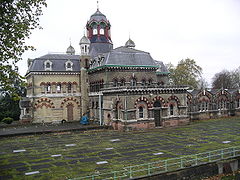Abbey Mills Pumping Stations
| Abbey Mills Pumping Station | |
|---|---|
 |
|
|
Location within London
|
|
| Alternative names | "The Cathedral of Sewage" |
| General information | |
| Status | in use |
| Type | pumping station |
| Architectural style | Italian Gothic |
| Address | Abbey Lane |
| Town or city | London |
| Country | England |
| Coordinates | 51°31′51″N 0°00′03″W / 51.5307°N 0.000835°W |
| Construction started | 1865 |
| Completed | 1868 |
| Design and construction | |
| Architect | Charles Driver, Edmund Cooper |
| Engineer | Joseph Bazalgette |
|
Listed Building – Grade II*
|
|
| Designated | 6 November 1974 |
| Reference no. | 1190476 |
The original Abbey Mills Pumping Station, in Abbey Lane, London, is a sewage pumping station, designed by engineer Joseph Bazalgette, Edmund Cooper, and architect Charles Driver. It was built between 1865 and 1868, housing eight beam engines by Rothwell & Co. of Bolton. Two engines on each arm of a cruciform plan, with an elaborate Byzantine style, described as The Cathedral of Sewage. Another of Bazalgette's designs, Crossness Pumping Station, is located south of the River Thames at Crossness, at the end of the Southern Outfall Sewer. A modern pumping station (F Station) was completed in 1997 about 200 metres (660 ft) south of the original station.
The pumping station was built at the site of an earlier watermill owned by the former Stratford Langthorne Abbey, from which it gained its name. It was first recorded as Wiggemulne in 1312, i.e., "the mill of a man called Wicga", an Old English personal name, and subsequently became associated with the abbey. The Abbey lay between the Channelsea River and Marsh Lane (Manor Road). It was dissolved in 1538. By 1840, the North Woolwich railway ran through the site, and it began to be used to establish factories, and ultimately the sewage pumping stations.
The pumps raised the sewage in the London sewerage system between the two Low Level Sewers and the Northern Outfall Sewer, which was built in the 1860s to carry the increasing amount of sewage produced in London away from the centre of the city.
...
Wikipedia

